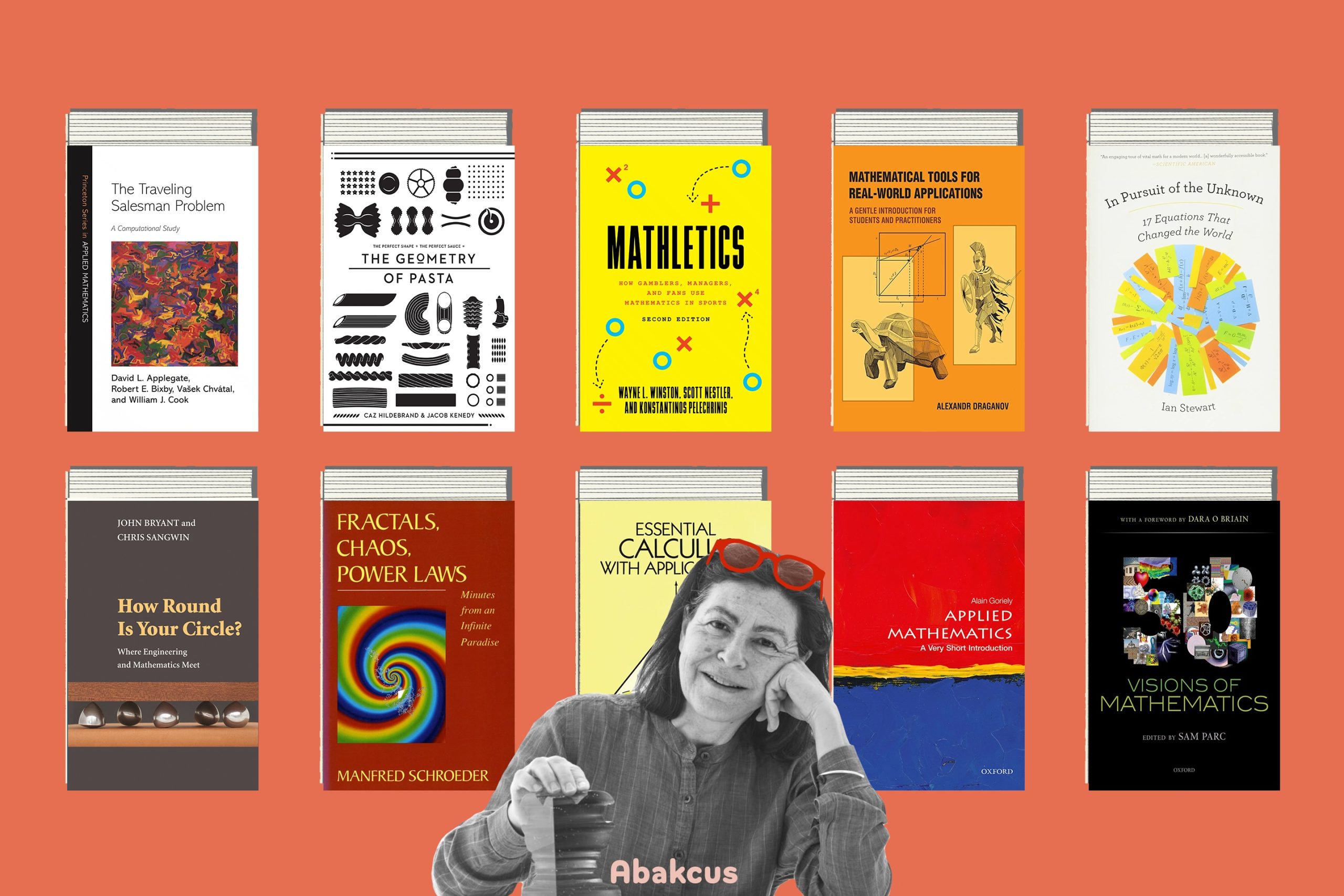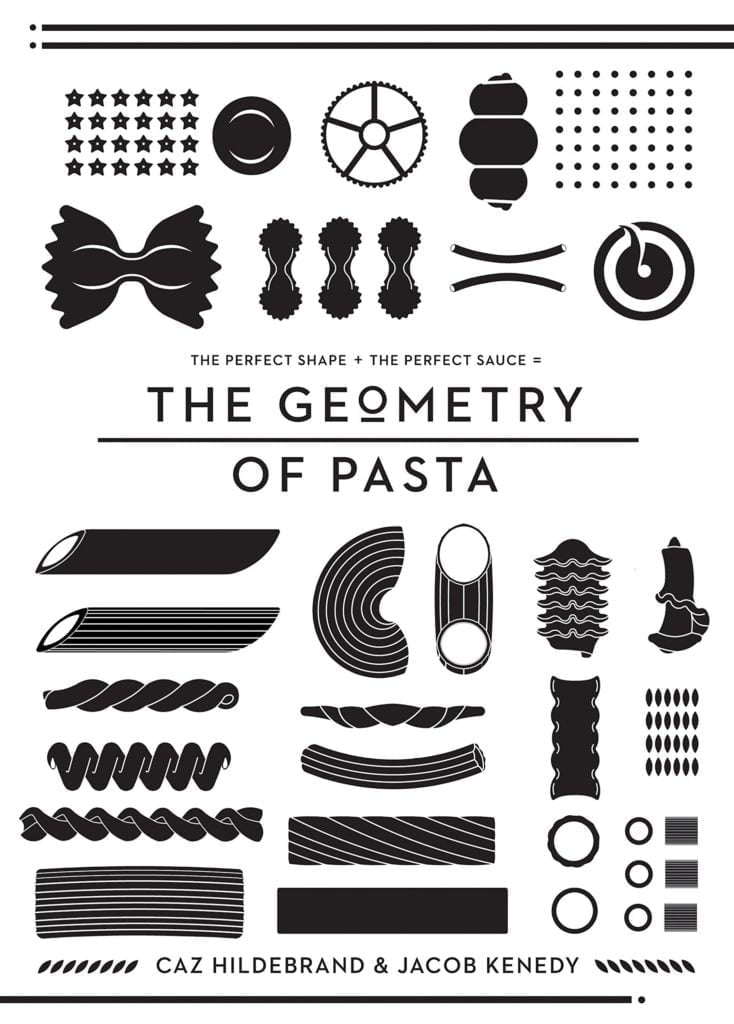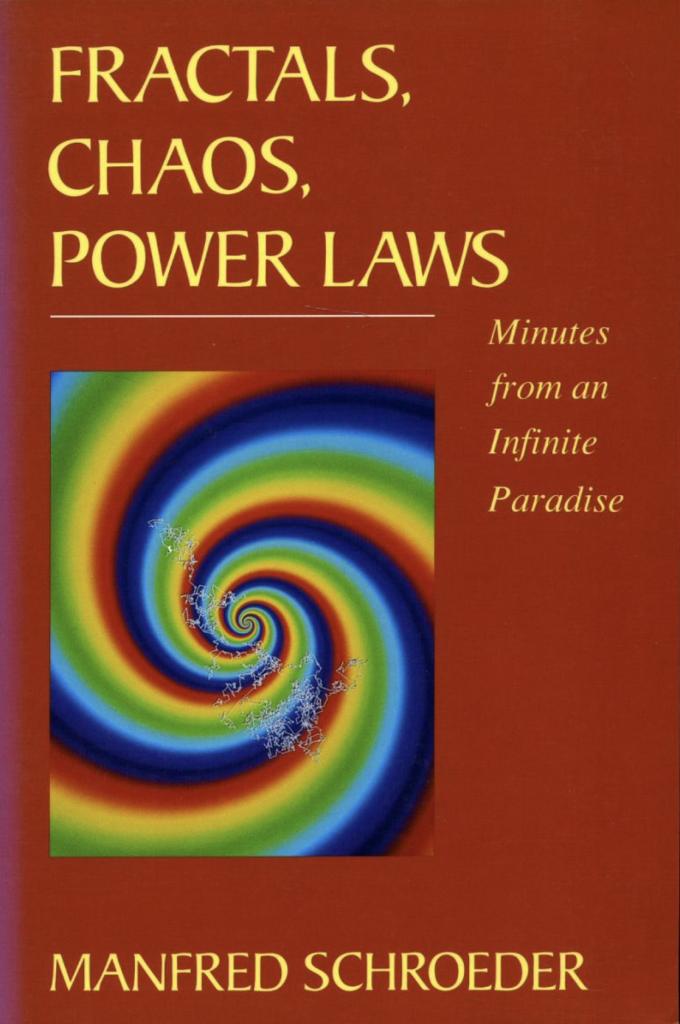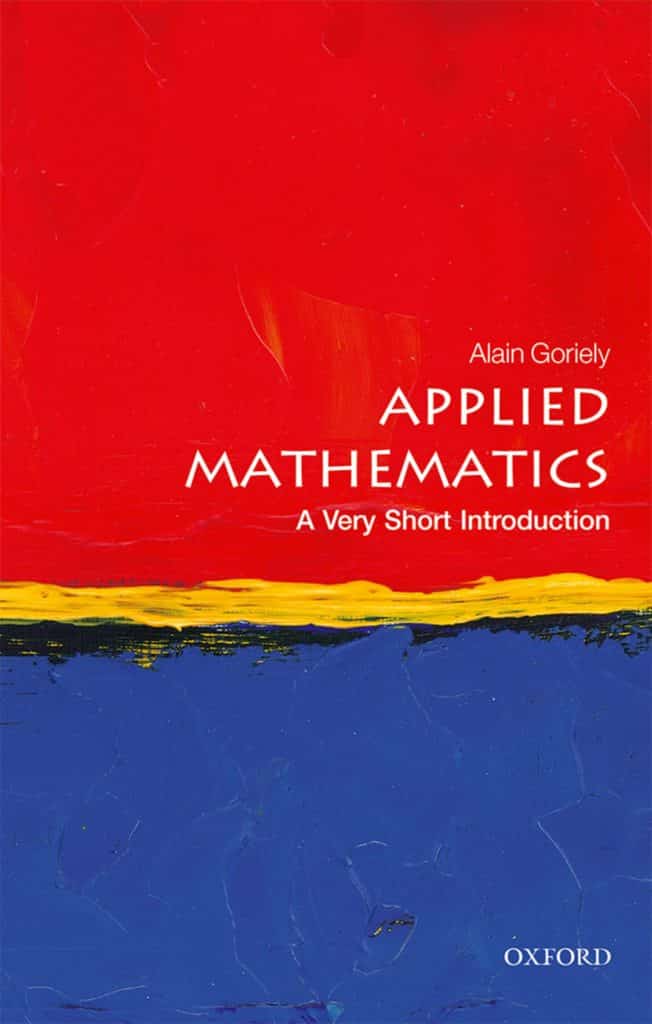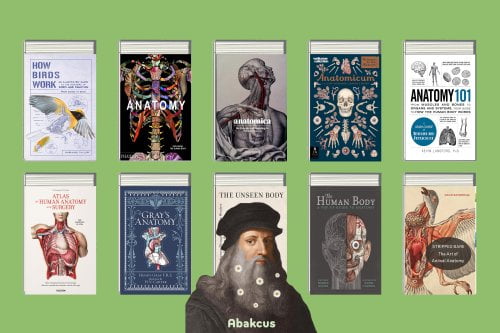Mathematics is often seen as a purely academic subject, confined within the walls of classrooms and textbooks. However, its reach extends far beyond, permeating nearly every aspect of our daily lives. From the intricacies of natural patterns to the digital algorithms governing modern technologies, math provides a language for understanding and innovation.
The following list of books about application of mathematics illuminates the diverse applications of mathematics, showcasing how this abstract science shapes our reality, influences various fields of research, and addresses complex problems. Whether you’re a math enthusiast, a professional seeking to expand your knowledge, or a curious mind captivated by the power of numbers, these books about application of mathematics offer enlightening insights into the practical magic of mathematics.
Books About Applications of Mathematics in Everyday Life
Books about applications of mathematics can illustrate how math is used in everyday life. For example, there are books about the application of mathematics to finance, which can help you better understand investments and other financial decisions. Or books that focus on scientific applications will teach you about physics, astronomy, meteorology, and more. Additionally, plenty of books discuss practical problem-solving strategies like algorithms and data structures or even programming languages like Python or Java. All these topics have an underlying mathematical basis, and having a solid understanding of this concept will give you an advantage when trying to master them.
Applications in the Professional World
Books on applications of mathematics can also help you prepare for a career in any number of fields where math plays a major role. For example, engineering fields such as aerospace engineering or civil engineering use mathematics extensively to design projects or create models that simulate real-world scenarios. Similarly, biotechnology uses mathematical models to predict the effects of different drugs or treatments on the human body. And many business fields rely heavily on statistics and probability to analyze data and make informed decisions. Knowing how math works in these professional contexts can give you an edge when interviewing for jobs in these industries and when working on related projects.
10 Good Books About Applications of Mathematics

Overall, reading books about applications of mathematics provides insight into how math applies to our lives both inside and outside the classroom—giving us a greater appreciation for its power and potential! For those interested in pursuing a career in any field related to mathematics or just wanting to understand its importance better, reading books about applications is one way to get started! So check out the books about applications of mathematics below! It could be your gateway into unlocking the power of mathematics!
If you enjoy these books, you may also want to see 30 Best Math Books to Learn Advanced Mathematics for Self-Learners.
Imagine being armed with a strong foundation in mathematical concepts, only to find yourself struggling to apply them in real life. The truth is, the problems you encounter outside of the textbooks are a whole different ballgame. They’re messy, time-consuming, and the usual solution recipes just won’t cut it. But fear not, because Mathematical Tools for Real-World Applications is here to bridge the gap between theory and practice.
In “Mathematical Tools for Real-World Applications,” you’ll discover six game-changing tools that will transform your approach to analysis, research, and problem-solving. From dimensional analysis to the method of successive approximations, these techniques will empower you to tackle real-life challenges head-on.
But Mathematical Tools for Real-World Applications isn’t just a book of equations to solve. No, it goes beyond that. It delves into analysis and uncovers the deep connections between the equations and their applications. Each chapter introduces a set of ideas and techniques, then demonstrates their real-world relevance through a series of problems. And don’t worry, you won’t need advanced calculus skills to make the most of this book—some knowledge of algebra and trigonometry will suffice.
Towards the end, the final two chapters bring it all together. They showcase how these six techniques can be combined and applied to solve two gripping real-life problems: calculating the probability of a catastrophic event and tracking a satellite with a GPS receiver. Through these examples, you’ll gain valuable insights and learn how to analyze, dissect, and interpret the results. In short, you’ll see how these tools actually work their magic in the wild, rather than in the sterile environment of a textbook.
To top it off, the appendix generously provides solutions to many of the problems scattered throughout the book. So, you can test your newfound skills and reinforce your understanding along the way.
But wait, there’s more! The author, Alexandr Draganov, has a remarkable gesture in light of the current war in Ukraine. For the first year, he will generously donate 100% of his royalties to support medical and humanitarian efforts in his homeland. By reading this book, you’ll not only enhance your mathematical prowess, but also contribute to a worthy cause.
So, if you’re ready to unlock the true potential of math, grab a copy of “Mathematical Tools for Real-World Applications” and embark on a journey that will forever change your relationship with numbers and equations.
Mathematics is a fascinating subject that can be applied in solving problems in various industries, including sports. Mathletics: How Gamblers, Managers, and Sports Enthusiasts Use Mathematics in Baseball, Basketball, and Football by Wayne L. Winston reveals how mathematics is used in evaluating players and improving team performance. In this book review, you will delve into the fascinating world of sports and mathematics, and learn more about the practical skills that can enhance our understanding and enjoyment of favorite sports.
Mathletics is a comprehensive guide that provides insights into the mathematical methods used by top coaches and managers in evaluating players and team performance. This book features new data, new players and teams, and new chapters on soccer, e-sports, golf, volleyball, and gambling Calcuttas. Mathletics has detailed chapters on various statistical techniques such as Bayesian inference and ridge regression, providing the reader with an in-depth understanding of each concept.
One of the most intriguing revelations in Mathletics is why baseball teams should almost never bunt. The book explains that bunting decreases a team’s run-scoring potential and reduces the number of outs they have available to score runs. Additionally, football overtime systems have been debatable for some time now with some teams having a higher chance of winning purely by winning a coin toss. Mathletics provides an explanation of why overtime systems are unfair.
Furthermore, Mathletics provides the reader with a better understanding of the NBA’s best player. Many people believe that the best player should possess high points, rebounds, and assists to his name. However, Mathletics points out that basketball is a team sport, and individual statistics alone may not help identify the best player. The book argues that using a combination of individual statistics and team performance is the most appropriate way to identify the best player in the league.
Finally, Mathletics has an informative chapter on gambling Calcuttas. These are auctions commonly used in sports betting, where players’ available bids receive a share of the proceeds from the overall auction pool. With the help of mathematical models, participants can determine their optimal bids that will earn them maximal expected value.
In Mathletics, Wayne L. Winston provides readers with valuable insights into how different mathematical methods are used in evaluating players and team performance. The book is not only informative but also entertaining for both sports enthusiasts and mathematical minds. It shows how a sound comprehension of mathematics within sports can provide a competitive edge by giving individuals a data-driven approach. The author illustrates the importance of statistics in sports and the significance of using them to gain an edge in sports betting. Mathletics is a must-read for anyone who wants to learn how to use mathematics to enjoy their favorite sports more.
Have you ever looked at a plate of pasta and wondered about the mathematical patterns in the shapes? If so, you need to get your hands on Caz Hildebrand’s book, The Geometry of Pasta. This visually stunning book is part cookbook, part math lesson that explores the mathematical shapes and structures behind some of our favorite comfort food.
The Geometry of Pasta by Caz Hildebrand is an amazing book that combines math, art, and food. It is a unique experience that draws you in with its creative story and captivating illustrations. Whether a math person or a book lover, this book has something for everyone.
The Geometry of Pasta is divided into two sections. The first section covers the basics of geometry, explaining why some pasta shapes are better than others for different sauces and flavors. It includes detailed descriptions of the history and evolution of each shape, as well as diagrams to illustrate how they fit together. The second section contains over 50 recipes incorporating these basic geometrical shapes into delicious meals.
Hildebrand’s writing style is light and entertaining. She takes complex concepts like trigonometry and makes them accessible by connecting them to everyday items like spaghetti or penne rigate. The book also provides helpful sidebars that provide additional insight into topics like Italian culture or food science. Combining her knowledge of mathematics with her passion for cooking, Hildebrand has created an engaging story about how humans have used geometry to create flavorful dishes throughout history.
The Geometry of Pasta follows the journey of two friends—Chef Jacob Kenedy and award-winning designer Caz Hildebrand —on their quest to make the perfect pasta dish. From shapes to angles to measurements, this book entertainingly introduces basic geometry concepts. You will love following along as Kenedy and Hildebrand work together on their recipe while learning some mathematical principles.
Another reason The Geometry of Pasta is so special is its beautiful illustrations. Created by award-winning artist Caz Hildebrand, each page features stunning visuals to draw readers in. The black-and-white colors and detailed drawings bring the story to life, making it even more enjoyable for readers.
Whether you are a math person or not, The Geometry of Pasta is a great read for anyone interested in learning more about the geometry or just wanting to have fun with friends! Even if you do not consider yourself a “math person” per se, do not worry – this book inspires and motivates readers!
To summarize, if you want to learn more about geometry or look for an interesting coffee book, look no further than The Geometry of Pasta by Caz Hildebrand! This beautiful book combines math concepts with art and food and will surely become one of your favorite reads! So grab your copy today – you will not regret it!
In a surprising turn of events, my journey into the world of mechanical engineering took me to a place I never imagined. Working on innovative automotive pushrods brought me face-to-face with the complexities of geometry and the importance of precision in design. Little did I know, measuring roundness and concentricity can be extremely challenging without sacrificing the pushrods themselves!
While “How Round Is Your Circle?: Where Engineering and Mathematics Meet” may not directly address this dilemma, it certainly delves into intriguing related questions. How does one draw a straight line? How can you verify the roundness of a circle? Surprisingly, these seemingly trivial problems play a vital role in engineering design. In How Round Is Your Circle, the authors aim to show mathematicians the significance of practical engineering problems and how small changes can have a big impact.
The authors’ fascination with analog scientific instruments is evident throughout the book. They include a range of physical models and provide instructions on how to make and use them. From hatchet planimeters crafted from coat hangers and washers to ingenious linkages, these models offer a hands-on exploration of mathematical concepts.
While How Round Is Your Circle? lacks a cohesive storyline, it is a treasure trove of captivating content for those who share the authors’ passion. It covers geometry, trigonometry, and elementary calculus, offering valuable examples and applications that can be applied in educational settings. However, it falls short of truly exploring the vast intersection of engineering and mathematics.
In “How Round Is Your Circle?“, the authors offer a glimpse into an intriguing world where precision and innovative thinking collide. While it may not fully live up to its title, it certainly sparks curiosity and offers a thought-provoking exploration of the meeting point between two fascinating fields.
Imagine you have a map with a collection of cities and a table showing the distances between each city. Now, picture trying to find the shortest path that passes through every city once and then returns to the starting point. That’s the traveling salesman problem (TSP) in a nutshell.
While it may not seem like something you’d encounter in everyday life, the TSP actually has many important applications. For example, imagine you’re manufacturing printed circuit boards and need to drill holes at specific points. You want to find the most efficient plan to move the drilling tool around the board, visiting each hole in the least amount of time. The TSP also holds theoretical interest in computer science as one of the most important NP-Hard optimization problems.
However, solving the TSP efficiently is a challenge. It’s an NP-Hard problem, which means finding a polynomial time algorithm for its solution is highly unlikely. Instead, researchers and practitioners have focused on developing efficient heuristics and approximation algorithms to tackle the TSP. But that doesn’t mean there haven’t been advancements in exact methods for solving the TSP.
Back in 1954, a major breakthrough was achieved in solving a TSP with 49 cities, spanning all 48 states and the District of Columbia. Dantzig, Fulkerson, and Johnson formulated the problem as an integer linear programming problem and solved it by adding constraints called “cuts” to strengthen the linear programming relaxation. Fast forward to the 1980s, cutting-edge methods like cutting plane methods, which combine problem-specific cutting planes with branch and bound techniques for integer linear programming, started gaining attention for solving TSP and other combinatorial optimization problems.
In 1988, the authors of The Traveling Salesman Problem: A Computational Study formed a team and embarked on their own TSP journey, using the branch and cut approach along with heuristic methods. Their hard work paid off, as they made significant progress in solving large-scale TSP instances, leading to the development of their branch and cut solver, Concorde. Concorde has successfully tackled TSP instances with over 85,000 cities. The Traveling Salesman Problem: A Computational Study serves as a research monograph, summarizing their extensive work on the TSP.
The Traveling Salesman Problem: A Computational Study starts off by diving into the history of the TSP and its real-world applications. Next, the authors delve into various cutting planes for the TSP, including their latest contributions to the Concorde solver. They also tackle important computational issues, such as managing LP relaxations and cuts, the LP solution process, branching strategies, and heuristic methods for finding optimal tours. Finally, the book concludes by exploring future approaches to solving even larger TSP instances.
The authors do an outstanding job of explaining how they developed new techniques to overcome the challenges posed by increasingly larger TSP instances. This book serves as a brilliant example of how theoretical research can be translated into practical software that tackles complex optimization problems once thought to be unsolvable.
Graduate students and researchers working on the TSP will find this book incredibly valuable. It’s also of interest to researchers using branch and cut methods to solve other combinatorial optimization problems. However, while the book is well-written, it’s not ideal for use as a textbook. Those seeking an introduction to the techniques used in The Traveling Salesman Problem: A Computational Study would be better served by the textbook “Combinatorial Optimization” by Cook, Cunningham, Pulleyblank, and Schrijver.
Discover the fascinating world of equations in “In Pursuit of the Unknown: 17 Equations That Changed the World” by Ian Stewart. Whether you’re a math phobe or a research mathematician, this book promises to captivate you with the poetry and beauty of significant equations. Brace yourself for a thrilling journey through the ascent of humanity, as Stewart unravels the secrets behind 17 equations that have truly transformed our world.
Prepare to be amazed as Stewart effortlessly breaks down complex equations from mathematics, physics, information theory, and finance in a way that anyone can understand. From Maxwell’s equations that birthed radio and wireless communication, to Newton’s law of gravity that led to the Hubble telescope and GPS, these equations have shaped our lives in ways we never imagined.
But don’t worry, In Pursuit of the Unknown isn’t all about equations and technical jargon. Stewart incorporates plenty of pictures and engaging prose to keep you hooked. Each chapter focuses on a different equation, giving you a comprehensive history, explanation, and significance of the equation. With helpful graphics and concise answers to key questions, you’ll feel confident in your understanding and eager to learn more.
Delving into the lives of the mathematical greats behind these equations, Stewart adds a touch of human-interest to the mix. You’ll meet fascinating characters like Cardano, the gambling scholar, and uncover how their discoveries have impacted our world.
Even experienced mathematicians will find something new in “In Pursuit of the Unknown.” Stewart’s approach showcases how to write about mathematics for a wide audience while providing deep insights into the profound influence of equations on modern civilization.
Whether you’re studying math, interested in history, or simply seeking an enjoyable read, In Pursuit of the Unknown is a must-have. Stewart’s inviting tone, comprehensive content, and compelling arguments breathe life into those enigmatic mathematical objects we call equations. Get ready to be amazed and inspired by the incredible power these equations possess.
“50 Visions of Mathematics” is a book that challenges this stereotype by covering a wide range of topics from biographies to recreational mathematics. The editor includes some lesser known figures and problems in addition to well-known ones, making this book an exciting read for anyone looking to learn more about mathematics. With equations used only when necessary and crisp diagrams used to effectively explain concepts, this book is accessible to high school students with basic math knowledge.
50 Visions of Mathematics‘ introduction begins with a refreshing perspective on the allure of mathematics. The editor explains how mathematicians view math as an art form that involves exploring patterns and discovering connections between seemingly unrelated ideas. This philosophy guides the book’s structure as it jumps between topics in a non-linear way.
One of the most interesting features of 50 Visions of Mathematics is the inclusion of biographies of mathematicians who often go unrecognized for their contributions to the field. For example, the book includes a section on Philippa Fawcett, a woman who received the highest score on the Cambridge Mathematical Tripos exam in 1890, but was not awarded a degree because women were not allowed to receive degrees at the time. Her story is just one of many examples that demonstrates how important it is to recognize historically marginalized voices in the field of mathematics.
“50 Visions of Mathematics” also includes sections on recreational mathematics, which involves applying math concepts to puzzles and games. These sections are particularly engaging because they make math feel less like a chore and more like a fun pastime. For example, there is a section on the tower of Hanoi puzzle, which challenges players to move a stack of disks from one peg to another while following certain rules. It’s a great way to introduce students to the concepts of problem-solving and critical thinking.
Another great feature of the book is the effective use of visuals to explain concepts. Diagrams are used throughout the book, and they are well-designed and easy to understand. For example, there is a diagram that explains the concept of chaos theory by showing how small changes in initial conditions can lead to vastly different outcomes. The visual representation makes this abstract concept much more concrete and comprehensible.
Finally, 50 Visions of Mathematics is a great tool for high school math classes. The content is accessible to students with basic math knowledge, and the non-linear structure of the book means that it can be used as a homework reading tool or as a jumping-off point for discussions and debates in class. The inclusion of biographies and recreational mathematics sections makes the book more engaging and relatable to students, while the effective use of visuals makes the content more accessible to visual learners.
50 Visions of Mathematics is an excellent book that challenges the stereotype of math being a dry and boring subject. The inclusion of biographies and recreational mathematics sections, as well as the effective use of visuals, makes the content engaging and accessible to students of all levels. It’s a great resource for high school math classes that can be used as a homework reading tool or as a way to spark discussions and debates in class. Ultimately, 50 Brief Visions of Mathematics serves as a reminder that math is not just a tool for solving equations, but a fascinating and endlessly creative field that is worth exploring.
“Essential Calculus with Applications” by Richard A Silverman lives up to its promises. It takes you on a mathematical journey, ensuring you understand every step along the way. And the best part? It assumes you only have basic knowledge of algebra and geometry.
What sets this book apart is its attention to detail. It not only teaches you the concepts, but also shows you how to pronounce those tricky symbols you encounter. And let me not forget to mention the abundance of proofs, including the one that proves the square root of 2 is irrational.
Before diving into calculus, Essential Calculus with Applications covers essential topics like sets, graphing, equations, and even a bit of trigonometry. Then, it eases you into calculus by introducing a concept and immediately showing its practical applications.
From limits to derivatives, integrals to related rates, and even partial derivatives, this book covers it all. And not to worry, there are answers to the problems at the back of the book.
Sure, it was written back in the 1970s, but don’t let that deter you. The technology may be a bit outdated, but the content is timeless. Essential Calculus with Applications is a must-read for anyone looking to unlock the world of higher mathematics. Trust me, it’s worth the journey.
Fractals, Chaos, Power Laws. The title itself sounds intriguing, doesn’t it? This book is a portal to an intricate world of self-similarity and scaling, where patterns repeat on different scales and a tiny change can lead to a large effect. Written by Manfred Schroeder, a renowned physicist, Fractals, Chaos, Power Laws is a journey through the fascinating concepts of fractal geometry and chaotic dynamics. From the patterns of snowflakes to the fluctuations of stock prices, and from the branching structures of trees to the sounds music produces, this book encompasses a vast array of examples to illustrate its themes. Keep reading to find out why Fractals, Chaos, Power Laws is a must-read.
Fractals, Chaos, Power Laws is a treasure trove of information for physicists, engineers, and other scientists with a mathematical background. Schroeder assumes a basic understanding of differential equations, probability theory, and calculus, but his writing style is straightforward and accessible. He makes the concepts easy to digest by breaking them down into bite-sized chunks and providing colorful illustrations. Even those with general knowledge in these subjects will find the book illuminating.
One of the most remarkable aspects of Fractals, Chaos, Power Laws is how interdisciplinary it is. Schroeder draws examples from physics, biology, finance, and music to illustrate his themes. He shows how fractals pop up in diverse contexts, from the shapes of coastlines to the structure of DNA. He also explains how chaotic dynamics underlie many natural and artificial systems, from the weather to traffic congestion. And he demonstrates how power laws, a type of statistical distribution that describes many phenomena, can be derived from simple principles.
Fractals, Chaos, Power Laws covers a wide range of topics. Some of the highlights include a detailed explanation of the Mandelbrot set, a famous fractal that has captured the imagination of mathematicians and artists alike; an analysis of the noise reduction properties of fractal antennas; a discussion of the Fibonacci sequence and its connection to plant growth; and a chapter on the physics of music that introduces the idea of musical fractals. Each topic is presented with a depth of detail that is both engaging and informative.
Schroeder’s writing is not only informative but also entertaining. He has a knack for weaving together technical information and anecdotes. For instance, he describes how Benoit Mandelbrot, the father of fractal geometry, stumbled upon the discovery of fractals while working at IBM. Schroeder also tells the story of how Johann Sebastian Bach incorporated mathematical principles into his music, creating pieces that resonate with the same self-similar patterns found in fractals.
Fractals, Chaos, Power Laws is a stunning book that takes readers on an eye-opening journey into the world of self-similarity and scaling. The book is comprehensive, interdisciplinary, and entertaining, making it a valuable resource for anyone interested in fractals and chaos. Although it is aimed at physicists, engineers, and other scientists with a mathematical background, it is still accessible to a broader audience. Whether you are a student, a teacher, or a layperson, Fractals, Chaos, Power Laws will expand your understanding of the beauty and complexity of the natural world. Don’t miss out on this must-read book!
Mathematics is often considered a daunting subject, filled with complex equations and formulae. But what if you could learn about the practical application of mathematics in a fun and accessible way? This is precisely what Applied Mathematics: A Very Short Introduction offers. Written by mathematician and theoretical physicist, Alain Goriely, this book provides readers with a glimpse into the fascinating world of applied mathematics.
The book, part of the Oxford University Press’ Very Short Introduction series, is designed for anyone with a basic understanding of calculus and physics. However, what sets it apart is its engaging approach to presenting complex topics. Goriely shares his personal journey of initially dismissing applied mathematics but later realizing its beauty and importance. Enthusiastically, he attempts to define the subject through three main components: modeling, theory, and methods, which are discussed in detail in the book.
Applied Mathematics: A Very Short Introduction is divided into nine chapters, each focusing on different examples and tools used in applied mathematics, such as dimensional analysis and differential equations. Readers will learn about the role of mathematics in fields like mechanics, biology, and finance. The book also touches upon modern issues in applied mathematics, including data analysis and the study of networks.
One of the most intriguing aspects of Applied Mathematics: A Very Short Introduction is the author’s ability to make abstract concepts tangible. Take, for example, modeling. Goriely explains how this process allows scientists to create simplified representations of complex systems, making them easier to understand. He goes into detail on how models are created, tested, and refined to ensure their accuracy. The chapter on differential equations is equally riveting, demonstrating how this mathematical tool is integral to understanding everything from the spread of disease to the optimal angle for a ski jump.
What makes Applied Mathematics: A Very Short Introduction so special is its ability to engage readers regardless of their mathematical background. Even those who may have found calculus or physics intimidating in school will find the book approachable and even enjoyable. Goriely’s writing style is engaging and he uses real-world examples to illustrate challenging concepts, helping readers to understand and appreciate the beauty of applied mathematics.
In conclusion, Applied Mathematics: A Very Short Introduction is a must-read for anyone interested in mathematics and its practical applications. This book is not only informative but also engaging, providing readers with a glimpse into the exciting world of applied mathematics. Despite being part of a series of short books, this one delves deep into the topic, providing an overview that is both accessible and enjoyable. Whether you are a student, researcher, or just someone looking to learn something new, Applied Mathematics: A Very Short Introduction is definitely worth a read.

